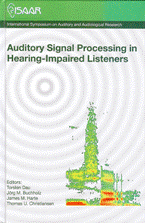Simultaneous reflection masking: dependency on direct sound level and hearing-impairment
Abstract
Simultaneous reflection masked thresholds (RMTs) were measured for 3 normal-hearing (NH) and 3 hearing-impaired (HI) subjects as a function of reflection delay. All stimuli were presented diotically and dichotically, using a 200-ms long broadband noise (100-50000 Hz) as input signal. For 55 dB-SL direct sound level, NH-listeners showed a binaural suppression effect for delays smaller than 7-10 ms and a binaural enhancement effect for larger delays. When decreasing the direct sound level to 15 dB-SL, the only significant change observed was that the dichotic RMT increased for delays larger than about 7 ms. In consequence, the binaural enhancement effect was strongly reduced, but the binaural suppression effect was unchanged. HI-listeners (at 30 dB-SL) showed a strong binaural suppression effect for delays smaller than about 3ms and only a very small binaural enhancement effect for larger delays. Hence, in contrast to binaural reflection enhancement, binaural reflection suppression seems to involve mechanisms that are robust to auditory-internal noise-floor and hearing-impairment. Moreover, differences between the RMTs for HI- and NH-listeners were in principal agreement with differences expected from changed auditory filter bandwidth and audibility. However, the level-dependency of the auditory filters’ bandwidth was not reflected in the SRMT data.
References
Buchholz, J. M. (2007). “Characterizing the monaural and binaural processes underlying reflection masking,” Hearing Research (in press).
Levitt, H. (1971). “Transformed up-down methods in psychoacoustics”. J. Acoust. Soc. Am., Vol. 49, 467-477.
Hall, J. W. and Harvey, D. D. G. (1984). “NoSo and NoSπ thresholds as a function of masker level for narrow-band and wideband masking noise,” J. Acoust. Soc. Am., Vol. 76, 1699-1703.
Moore, B. C. J. (2003). “An introduction to the psychology of hearing,” 5th edition, Academic press.
Salomons, A. M. (1995). “Coloration and binaural decoloration of sound due to reflections,” Dissertation, TU Delft.
Patterson, R. D. and Moore, B. C. J. (1986). “Auditory filters and excitation patterns as representations of frequency resolution,” in Frequency Selectivity in Hearing, edited by B. C. J. Moore, Academic Press, 123-177.
Shamma, S. A. (1985). “Speech processing in the auditory system II: Lateral inhibition and the central processing of speech evoked activity in the auditory nerve,” J. Acoust. Soc. A., Vol. 78, 1622-1632.
Yost, W. A. and Hill, R. (1978). “Strength of the pitches associated with ripple noise,” J. Acoust. Soc. Am., Vol. 64, 485-492.
Yost, W. A. (1982). “The dominance region and ripple noise pitch: A test of the peripheral weighting model,” J. Acoust. Soc. Am., Vol. 72, 416-425.
Zurek, P. M. (1979). “Measurements of binaural echo suppression,” J. Acoust. Soc. Am., Vol. 66, 1750-1757.
Additional Files
Published
How to Cite
Issue
Section
License
Authors who publish with this journal agree to the following terms:
a. Authors retain copyright* and grant the journal right of first publication with the work simultaneously licensed under a Creative Commons Attribution License that allows others to share the work with an acknowledgement of the work's authorship and initial publication in this journal.
b. Authors are able to enter into separate, additional contractual arrangements for the non-exclusive distribution of the journal's published version of the work (e.g., post it to an institutional repository or publish it in a book), with an acknowledgement of its initial publication in this journal.
c. Authors are permitted and encouraged to post their work online (e.g., in institutional repositories or on their website) prior to and during the submission process, as it can lead to productive exchanges, as well as earlier and greater citation of published work (See The Effect of Open Access).
*From the 2017 issue onward. The Danavox Jubilee Foundation owns the copyright of all articles published in the 1969-2015 issues. However, authors are still allowed to share the work with an acknowledgement of the work's authorship and initial publication in this journal.


